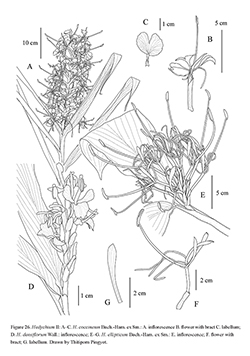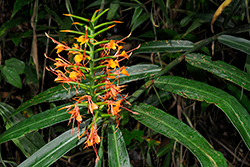e-Flora of Thailand
Volume 16 > Part 2 > Year 2023 > Page 583 > Zingiberaceae > Hedychium
5. Hedychium coccineum Buch.-Ham. ex Sm.wfo-0000435716
in Rees, Cycl. 17(2): Hedychium no. 5. 1811; Baker, Fl. Brit. India 6: 231. 1892; Gagnepain, Fl. Indo-Chine 6: 70. 1908; Smith, Fl. Bhutan 3 (1): 204. 1994; Wu & Larsen in C.Y.Wu & P.H.Raven (eds), Fl. China 24: 375. 2000; Wongsuwan & Picheansoonthon, J. Roy. Inst. Thailand 3: 133. 2011. Fig. 26 A–C.
Accepted Name : This is currently accepted.
Synonyms & Citations :
Description : Terrestrial herb. Leafy shoots 1–2 m tall; bladeless sheaths 1–3; leaf sheaths green to dull green, often glaucous, glabrous; ligule oblong, 2–3 by 1.4–1.6 cm, apex rounded to acute or shallowly bilobed, pubescent; blades (12–)18–29(–32), oblong to linear-oblong, (25–)35–45(–56) by 2.5–8.5 cm, glabrous above, pubescent on midrib below, base cuneate, apex long acuminate; sessile. Inflorescence a terminal spike, broadly oblong in outline, 20–54 cm long; peduncle 3–14 cm long, pubescent; bracts 36–57, not imbricate, dark green, folded, oblong, (2–)3.5–6 by (0.6–)1.5–1.6 cm, sparsely pubescent, apex acute, ciliate; bracteoles oblong, 0.7–2.7 by 0.5–1.5 cm, sparsely pubescent, apex unequally bilobed, (1–)3–6-flowered. Flowers ± half-resupinate, orange-red, rarely almost white with pinkish to flesh-coloured base, not to slightly fragrant; ovary 3–5 by 1.5–4 mm, densely long pubescent, ovules many; style filiform, ca 8 cm long; stigma green, margin ciliate; epigynous glands linear, blunt, 2–4 mm long; calyx ± as long as bracts, (1.6–)2.5–3.9 cm long, ca 0.4 cm diam., densely pubescent, apex 2–3-lobed; floral tube 2–3.6 by 0.2–0.3 cm, corolla lobes linear, 4 by 0.3 cm, apex hooded to acute; lateral staminodes reddish orange, rarely whitish, oblanceolate or obovate-cuneate, to long scimitar shaped, (1.6–)2.1–3.5 by (0.4–)0.6–1 cm, base attenuate into ca 1 cm claw, apex acute or mucronate, margin irregularly crenate; labellum reddish orange to whitish with darker red base, distinctly clawed, blade suborbicular, shallowly funnel-shaped by infolded-overlapped base, 1.5–3.1 by 1–2.3 cm, apex shallowly to deeply bilobed, to ½ of its length, lobe apex rounded to slightly emarginate; stamen coloured as labellum base, more than twice as long as labellum; filament 5–7 cm long; anther commonly darker in colour, 6–10 by 3–4 mm. Fruit ovoid-oblong, 2.6–3.8 by 2.3–2.5 cm, pubescent, green; seeds red, 9–15, ovoid, 4–5 by 3–4 mm, aril lacerate, red.
Thailand : NORTHERN: Mae Hong Son (Pai), Chiang Mai (Doi Ang Khang, Doi Chiang Dao, Doi Mae Ya, Doi Suthep-Pui), Nan (Doi Phu Kha).
Distribution : India, Sri Lanka, Nepal (type), Bhutan, Myanmar, S China, N Laos.
Ecology : Open pine-oak forests or grassy slopes in evergreen forests, 1,200–1,650 m alt.
Vernacular : Kha dong (ข่าดง), kha fai (ข่าไฟ)(Northern).
Notes: Hedychium coccineum is easily recognised by its bright red flowers but there are some flower-colour and leaf-shape variations which seem to be continuous and not co-related to each other. The unique character of H. coccineum is its shallowly funnel-shaped labellum formed by the infolded base.


